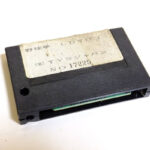As someone fascinated by the elegance of Victorian gowns, I often find myself dreaming of a time filled with elaborate layers, vibrant colors, delicate ribbons, and an overall sense of refinement. Being rooted in the Southwest, as an Arizona native and Daughter of Utah Pioneers now residing in Denver, I’ve developed a unique perspective. This blend of interests has sparked my curiosity about pioneer clothing and how the styles of the Western frontier diverged from the established fashions of Eastern cities during the 19th century.
Pioneer women faced numerous considerations when it came to their wardrobes, balancing practicality with societal expectations. From sheer convenience to maintaining a sense of class, and everything in between, I’ve explored the foundational elements of their clothing. This post will delve into the basics of pioneer fashion, with more insights to follow from my ongoing research.
Underneath It All: Pioneer Women’s Undergarments
Interestingly, the undergarments worn by women in frontier areas weren’t drastically different from those in eastern cities. The fundamental piece was the chemise, a lightweight cotton slip, prioritized for hygiene and regularly washed. Next, pantalets, crafted from flannel or cotton, were added for modesty – essential as underpants as we know them were not yet common.
Contrary to initial assumptions, most pioneer women did wear corsets over their chemise and pantalets. It’s important to remember that many women journeying west were driven by the pursuit of a better future for their families, whether for economic or religious reasons. They were “proper” women who valued societal norms and would have considered a corset a fundamental garment.
While women engaged in strenuous tasks might loosen or forgo their corsets while working around the home, the majority of frontier women likely brought corsets with them and wore them whenever feasible.
Following the corset came petticoats, often multiple layers depending on the formality of the occasion or the weather. Stockings were a must when leaving the house or receiving guests, typically held up by garters or tucked into pantalets. This last detail seems like it would be the most uncomfortable aspect of pioneer attire!
Fabrics of the Frontier: What Pioneer Clothing Was Made Of
Calico was the dominant fabric choice for pioneer clothing across the board. While often visualized as quaint floral prints, calico is actually a type of fabric made from unprocessed cotton, simply woven and lighter than modern canvas. Its lightweight, durable, and easy-to-clean nature made it ideal for the demands of outdoor living. Available at general stores, calico came in various dyed options, or women would dye it themselves using store-bought dyes or natural alternatives derived from leaves, bark, berries, or fruits.
Cotton and silk fabrics were still reserved for Sunday best and more formal dresses, and many women brought such outfits with them westward.
Fabrics were generally accessible at general stores, though the frequency of access varied greatly depending on location. For families in more isolated areas, making their own fabrics was a necessity, a topic deserving of its own exploration.
Everyday Essentials: Pioneer Women’s Daily Wear
 Alt text: Pioneer woman in simple dress and bonnet standing outdoors, depicting typical daily wear of the 1800s.
Alt text: Pioneer woman in simple dress and bonnet standing outdoors, depicting typical daily wear of the 1800s.
Regardless of their backgrounds in the East, women in frontier settlements were integral to establishing and maintaining homes and farms. Their days were filled with cooking, cleaning, childcare, laundry, and often fieldwork. The success of family farms depended on everyone’s physical labor, with no outsourcing of domestic duties. Frontier women quickly adapted to a life of constant manual work.
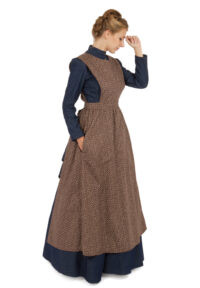 Alt text: Close-up of a calico apron, highlighting the fabric and practical design of pioneer aprons in the 1800s.
Alt text: Close-up of a calico apron, highlighting the fabric and practical design of pioneer aprons in the 1800s.
Pioneer Calico Apron
Popular dress styles of the time, featuring fitted bodices and full skirts, were adopted by pioneer women but adapted for practicality. Day-to-day dresses had skirts hemmed approximately three inches shorter, facilitating movement. Weights were sometimes sewn into hems to prevent skirts from blowing up in windy conditions.
Bodices remained fitted, but sleeves were loosened, extending to the wrists with high collars for sun protection.
Laundry was a significant chore. The book How the West Was Worn mentions “wash dresses”: “In 1867 a two-piece dress of white cotton with a printed background became popular due to its easy care and was sold in stores, then duplicated by seamstresses throughout the West. The garment was known as the “wash dress” because it could be laundered easily. Women from all socioeconomic backgrounds wore “wash dresses.” The “wash dress” highlights how fashion evolved to meet the practical needs of frontier life.
Sunday Best: Dressing Up for Church on the Frontier
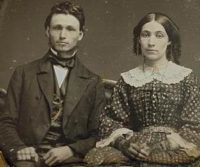 Alt text: Formal portrait of a pioneer couple in their Sunday best attire, showcasing 1800s frontier fashion for church.
Alt text: Formal portrait of a pioneer couple in their Sunday best attire, showcasing 1800s frontier fashion for church.
While some families lived remotely, settlements with multiple families typically had churches, and church attendance was a strong community norm. While accounts exist of women in impoverished communities attending church barefoot, it was more common for women to have dresses specifically for Sundays. However, historical records often focus on more privileged settlers, making it difficult to definitively know the most typical reality.
“Sunday best” on the frontier mirrored city fashions. Full skirts over petticoats and corsets were standard. Sleeve styles reflected current trends, including bell, leg-o-mutton, or pagoda sleeves. Skirt styles also followed fashion trends, such as crinoline, hoop, or bustle, depending on the decade.
Younger and newly married women favored lighter colors, transitioning to darker shades later in life. Sunday dresses were completed with fashionable hats, kid gloves, and low-heeled boots.
Social Occasions: Frontier Party and Dance Outfits
For those who could afford it, a separate dress was reserved for socializing, in addition to daily and Sunday attire. Dances, holiday celebrations, picnics, and other gatherings provided opportunities for community connection, and women, accustomed to dressing for occasions in the East, continued this practice on the frontier.
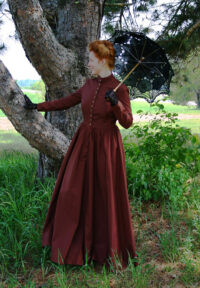 Alt text: An elegant Victorian cotton dress, representative of pioneer women’s formal wear for church and social events in the 1800s.
Alt text: An elegant Victorian cotton dress, representative of pioneer women’s formal wear for church and social events in the 1800s.
Mary Chestnut’s Americana Victorian Cotton Dress
These social dresses were highly valued. Women might order fabrics from general stores, eagerly anticipating the chance to create fashionable outfits. Godey’s Ladies Book was widely circulated and shared, its dress patterns and styles enthusiastically copied by frontier women.
Fabric availability for new dresses depended on the distance to towns and general stores. In less accessible areas, women might not have had a wide wardrobe. In such cases, their best dress served for special events, enhanced with embellishments like hand-crocheted collars and shawls, and other accessories.
Accessories: The Finishing Touches of Pioneer Attire
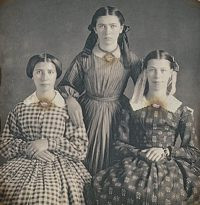 Alt text: Two young pioneer girls wearing bonnets and aprons, highlighting the importance of accessories in 1800s frontier children’s clothing.
Alt text: Two young pioneer girls wearing bonnets and aprons, highlighting the importance of accessories in 1800s frontier children’s clothing.
Accessories were surprisingly significant in frontier women’s wardrobes. Beyond hoop skirts and calico, the finishing touches were crucial. Jewelry and accessories were emphasized in historical accounts, and a detailed exploration of these items is planned for a future post.
Women on the frontier enjoyed accessorizing with:
- Aprons
- Boots
- Brooches
- Lockets
- Earrings
- Precious stones and metals
- Hair adornments
- Hats
- Collars and cuffs
- Gloves
- Undersleeves
- Parasols
- Fans
- Handbags
- Shawls
A Surviving Legacy
My own exploration into my pioneer ancestry has become a deeply engaging interest. Writing this post revealed that while “prairie style,” “pioneer,” and “western wear” clothing are readily available today, historical details about how women of this era balanced propriety, beauty, and fashion with the physical demands of frontier life are less common.
This topic is ripe for further study, and I invite you to follow my upcoming post on accessories in the frontier.
Create your own pioneer look:
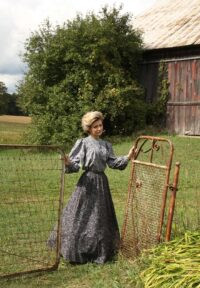 Woman in pioneer clothing standing in a field wearing a long-sleeved blue top and long blue skirt.
Woman in pioneer clothing standing in a field wearing a long-sleeved blue top and long blue skirt.
Pioneer Calico Blouse and Skirt
Browse our entire pioneer clothing collection
Pioneer Calico Blouse and Skirt
Harper Victorian Pioneer Dress
Pioneer Blouse, Apron and Skirt


